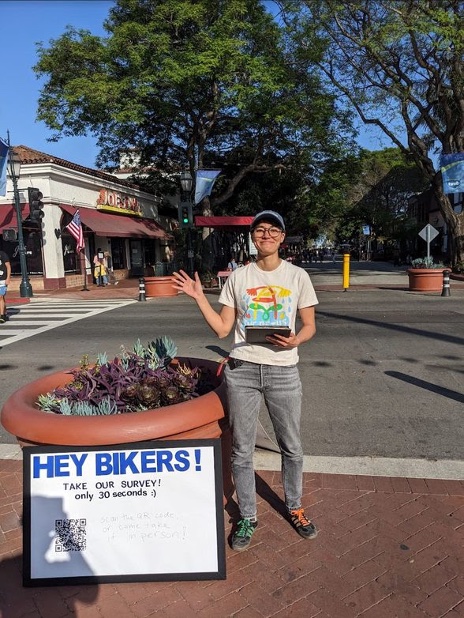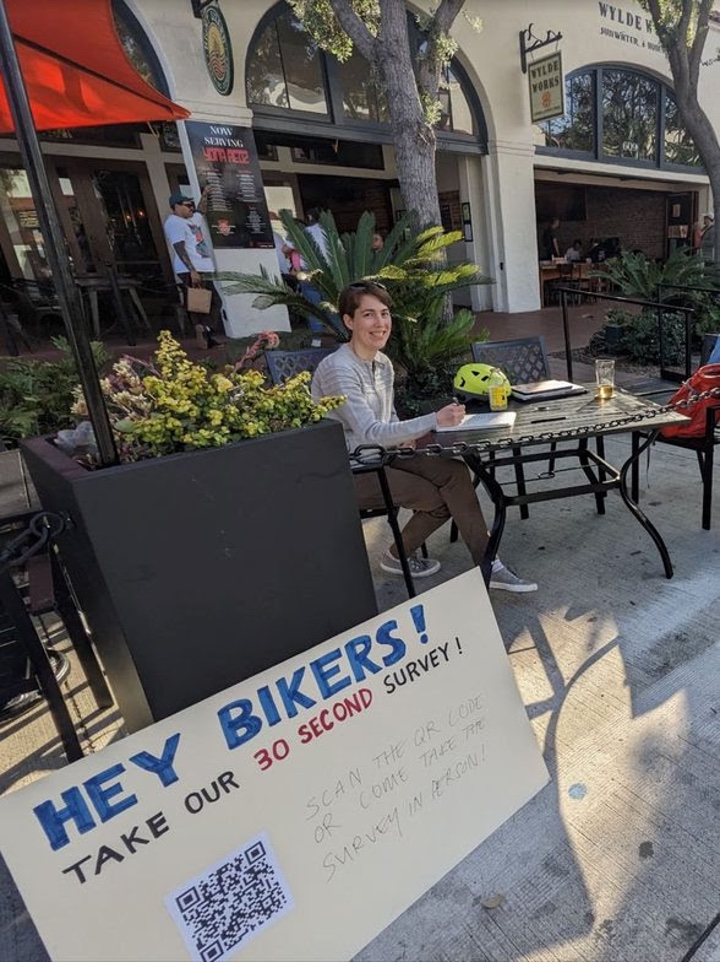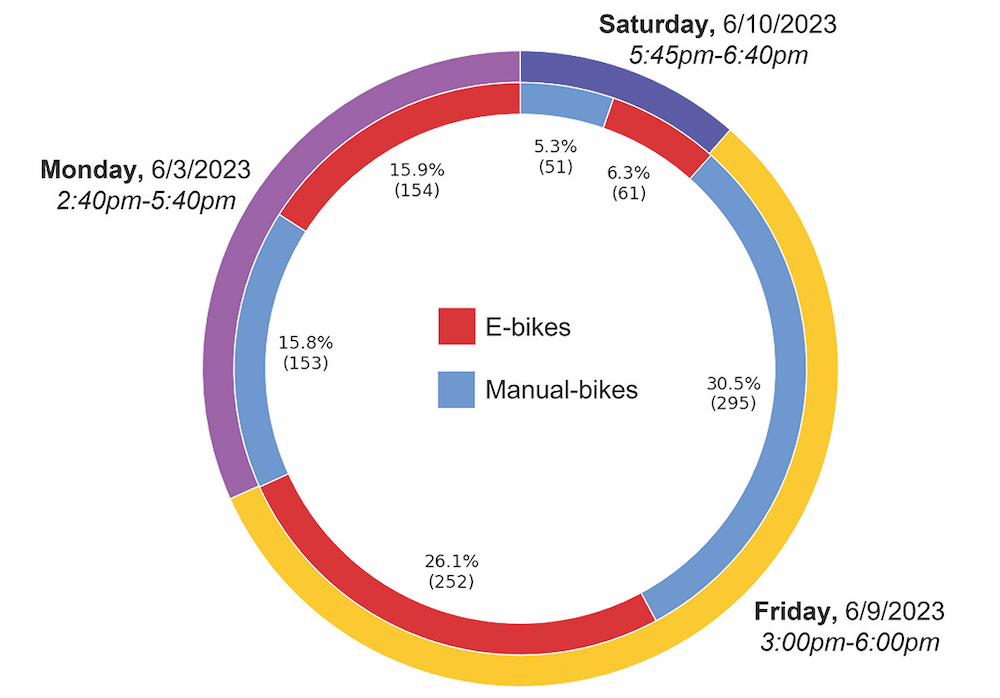STSB Part 3: Why Strong Towns SB Supports a “Flat and Flexible” State St.

Let me say this upfront: Of the three State Street designs presented to the State Street Advisory Committee by MIG Design at their meeting on May 24, the members of our local nonprofit advocacy group, Strong Towns Santa Barbara (STSB), support the “Flat and Flexible” option – the one most focused on the comfort and safety of pedestrians and cyclists.
As noted in my previous articles, the renderings presented on May 24 sparked noticeable controversy. Committee members and members of the public expressed many concerns, often centered around bicycles and their inclusion in all of the design options presented. For example, some committee members referred to the designs as “bike thoroughfares,” and others opposed the “massive percentage of space” given to cyclists. However, conspicuously absent from the discussion was any consideration of who bikers on State Street actually are. The committee members’ comments appeared to imply that they view most cyclists as either people rushing across town, or hapless children, but the STSB bicyclist intercept survey (results printed in the previous Part 2 article; MJ, June 29 – July 6) found that bikers on State Street spanned a wide range of ages, that they often biked to State Street to spend money (either at retail stores or at restaurants), and that most were locals.
If anything, the survey results appear to indicate that bikes are an integral part of the State Street promenade ecosystem, promoting both economic and community vitality while also serving as an emissions-free method of transport, a fun and immersive approach to sightseeing, and a means of achieving a vast array of other benefits (e.g., exercise, mental wellness, etc.). Yet, in spite of all these aspects regarding bikes that would seem to make them an asset to State Street and to the city as a whole, State Street Advisory Committee members and public commenters continue to denounce their presence in the downtown corridor. In light of this, I would like to use the remainder of this article to address several commonly expressed bicycle-related concerns while also laying out a case in favor of the “Flat and Flexible” design:
Cyclists are not part of the economy and/or do not spend as much as car drivers.
The presence of cyclists has repeatedly been shown to generate significant economic benefits for local businesses. As one article on the national Strong Towns website puts it, “the numbers are in”: Studies from San Francisco, New York, Seattle, Salt Lake City, and Los Angeles all reached the same conclusion: cyclists go to more shops and spend more money overall than people who drive. Likewise, when bike infrastructure is added to an area, sales and revenue increase, and the number of car collisions fall. One study from New York found that the addition of protected bike lanes on two major streets resulted in a 50 percent increase in sales tax at local businesses, while another in Los Angeles found that a section of road with newly-installed bike lanes saw business almost double as a result. A brief survey of Strong Towns Santa Barbara members finds that many of us have biked to State Street on many occasions, most often to patronize specific businesses or show off its beauty to visiting family and friends.

Further, with regards to “the decline of retail” on State Street, I highly recommend listening to Executive Director for Downtown Santa Barbara Robin Elander’s two-minute public comment from the June 27 City Council meeting on this topic. She provides compelling statistics which demonstrate that retail trends in Santa Barbara are directly correlated with ongoing national retail trends and are not the fault of the promenade being closed to cars.
One out of every five people who took our survey said they were biking on State Street because it was safer than the surrounding streets. By including designated bike lanes on State Street, the “Flat and Flexible” design option enables local businesses to benefit from cyclists looking to spend money downtown, while also maintaining a higher standard of safety for people of all ages seeking to enjoy Santa Barbara by bike.
We’re giving too much space to bikes.
State Street is 80 feet wide. MIG’s “Flat and Flexible” design proposes creating a 12-foot-wide bike path. That’s 15 percent of the total available width – an exceedingly reasonable value that seems even more so upon recollection of the fact that prior to the pandemic, cars dominated a majority of State Street’s width. Keep in mind too that California requires 20 feet of clear space for fire/emergency access, meaning that no matter what design is chosen, there will always be space that contains no seating, planters, or other features. Why not use 12 of the mandated 20 to accommodate bikes (thereby leaving the remaining 85 percent for pedestrians)?
Of all three options, the “Flat and Flexible” design gives the least space to cars on the State Street promenade, leaving plenty of room to be split up between bicycles and pedestrians.
If cycling requires so much design, why bother at all? Make the promenade pedestrian-only and ban bikes entirely, especially e-bikes.
Use is informed by design. That’s one of the most important things I learned while studying Transportation Engineering. If a road has few cross streets or stoplights and consists of wide lanes, people will drive on it at high speeds regardless of the posted speed limit. Conversely, if a road has features like speed bumps, turns, or short sight lines, drivers will slow down as the physical space demands they pay more attention. The same holds true for bikes: the existing 40-foot-wide, unmarked asphalt space in the middle of State Street invites unruly cycling behavior simply because no barriers to speeding exist there. Narrow the bike path to 12 feet – six feet in each direction – with frequent crosswalks and turns, and cyclists will be forced to slow considerably, while the more speed-prone cyclists will avoid the space entirely. This form of designing for use is not burdensome, but empowering; if we construct the downtown corridor correctly, the users we’re targeting will appear.
Cyclists and pedestrians coexist in common spaces across the world, and there are ample examples of successful implementation of this design methodology. One need not look far. At UCSB for example, 12-foot-wide cycling paths wind their way across the campus, paralleling and intersected by pedestrian walkways. Walk to the bottom of State Street, and you’ll find the Cabrillo Beach Path, where bikes and people have been thrown together in the same exact space. Rather than reading of constant crashes and injuries as one might expect based on claims made about State Street, people seem to coexist peacefully. That’s because the design informs the use: a narrow concrete path with plants/sand on either side keeps unruly/higher speed bikers away, while the constant need to pay attention to other users slows everyone down collectively. On my Medium.com website where I publish more articles (https://medium.com/@SullivanIsrael), I’ll be posting about more real-world examples.

Regarding e-bikes, I point again to our State Street bicycle counts survey, which showed that almost 50 percent of all bikes on State Street are e-bikes, with only a small handful of those being ridden by kids/teens. That said, banning e-bikes from State Street would effectively halve the number of cycling patrons currently traversing the State Street corridor. Also, as mentioned, if MIG’s “Flat and Flexible” design is adopted, all cyclists (regular bikers and e-bikers alike) will be forced to slow on State Street as noted above, and confining north- and southbound bikers to designated six-foot lanes will minimize the chances of bicycle-pedestrian encounters (which many are rightly concerned by on the current, unmarked version of State Street).
Additionally, when it comes to e-bikes, it is important that we consider the context surrounding State Street. While the main downtown corridor is relatively compact, Santa Barbara as a whole is large and spread out; biking to the promenade can be a long trip if traveling (as many do) from Goleta, for example. Likewise, for some, walking the whole length of the promenade can be physically taxing. A trip which might deter some merely due to its length is made much more approachable (and much less sweaty) by e-bikes. As far as micro-mobility options go, e-bikes are an excellent choice for residents of Santa Barbara where the temperate weather enables biking year-round and where things are just far enough apart that e-bikes – which increase the distance able to be traveled while also decreasing travel time without necessitating use of a car – are hugely beneficial. Their popularity on State Street is a clear indicator of e-bikes’ utility, and failing to account and provide safe spaces for the many e-bike users in Santa Barbara would be extremely shortsighted. Finally, the city’s highly successful BCycle e-bike program, which makes revenue while providing transportation to tourists and locals, would be for naught if bikes are banned.
Ultimately, the goal of the State Street design process is to create a lasting public space in the heart of our city that serves to promote local business, invite visitors from near and far to visit and spend time here, and which cultivates and enhances a unique, local feel. I urge Santa Barbara to try and approach this process progressively; rather than look back at previous pedestrian promenade designs, some of which failed in the late 20th century, we should include cyclists and other small-wheeled users to ensure State Street’s lasting vitality.
We at STSB have been advocating for keeping parklets erected and keeping State Street open for pedestrians and bikers. Many of our members have attended and spoken at city-held meetings and outreach events, as well as sent letters and public comments to city council and others. We are always on the lookout to promote a safer, more comfortable, enjoyable, and fiscally resilient community and will continue to advocate for the “Flat and Flexible” option. Hopefully it can be improved upon even more with time.
As always, if you’d like to help, please reach out (and check out our website at strongtownssb.org)!
Until next time,
Sully Israel







You must be logged in to post a comment.